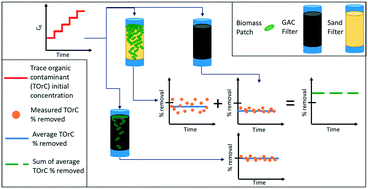Biodegradation and attenuation of MIB and 2,4-D in drinking water biologically active sand and activated carbon filters†
Abstract
Biofiltration for the control of two trace organic contaminants (TOrCs), 2-methylisoborneol (MIB) and 2,4-dichlorphenoxyacetic acid (2,4-D), in the presence of background dissolved organic matter (DOM) was examined. TOrC removal was monitored in biologically acclimated sand and granular activated carbon (GAC) filters and non-acclimated sand and GAC filters. TOrC biodegradation followed pseudo-first-order behavior as removal on a percentage basis remained constant when TOrC influent concentrations increased from 100 and 500 ng L−1 and greater removals were observed at longer empty bed contact times. Biomass concentrations on a bed volume basis in the acclimated sand filter were twice that found in the acclimated GAC filter, as the sand particles provided more external specific surface area for biomass attachment. When accounting for differences in biomass concentrations, greater TOrC biodegradation occurred in the acclimated sand filter, indicating that synergistic interactions between biodegradation and adsorption did not occur in the acclimated GAC filter. Equivalent amounts of TOrCs desorbed from the acclimated and non-acclimated GAC filters when TOrCs were no longer spiked into the influent. Thus, acclimated and non-acclimated GAC filters adsorbed similar amounts of TOrCs and biodegradation of adsorbed or desorbed TOrCs was negligible. After switching the primary substrate from non-ozonated to ozonated DOM, total organic carbon removal in the acclimated sand filter increased, but TOrC removal initially declined and then recovered over several days. TOrC removal in the acclimated GAC filter remained relatively constant before, during, and after DOM pre-ozonation, potentially because the residual adsorption capacity in the GAC attenuated fluctuations in TOrC biodegradation.



 Please wait while we load your content...
Please wait while we load your content...